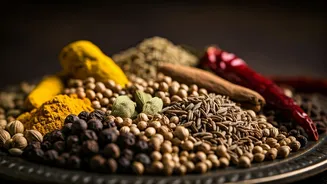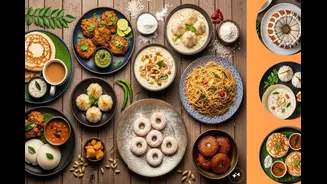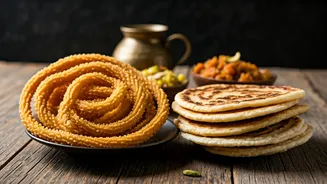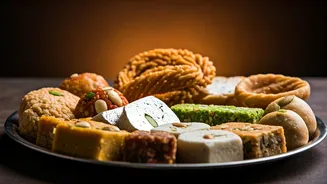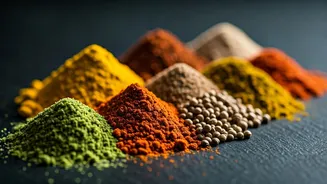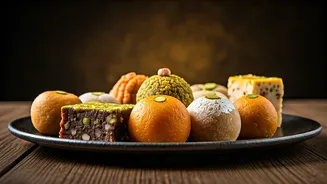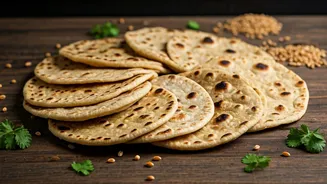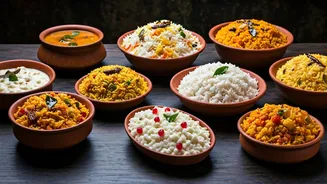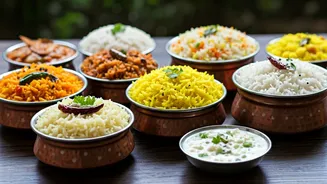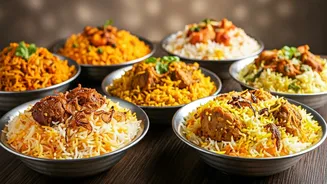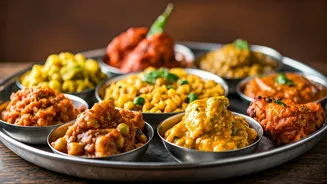A Land of Spices
The very essence of Indian cooking is deeply intertwined with the use of spices, which are more than just seasonings; they are integral parts of the culinary
heritage. Spices have always been a key part of Indian trade and cultural exchange for centuries. Indian cuisine's diversity originates from each region's unique climate, geography, and cultural practices. From the fiery chilies of Andhra Pradesh to the delicate cardamom of Kerala, spices impart a signature taste. The blending of spices, a skill perfected over generations, is what gives Indian food its distinct and complex character. This intricate blending can be seen in common spice mixtures like garam masala, which includes a balanced mix of cumin, coriander, and other ingredients, used to enhance the taste and aroma of dishes. The skillful use of spices is not just about taste; it also reflects the local heritage and practices of Indian cooking.
Regional Culinary Journeys
India's culinary scene is a mosaic of flavors, each region contributing its distinctive profile. North Indian cuisine, with its rich gravies and creamy textures, uses butter and cream in abundance. Dishes like butter chicken and various types of kormas are very popular in this region, prepared and savored across the country. South Indian food stands out with the use of rice, lentils, and the tang of tamarind. Dosas and idlis, which are common breakfast items, and the various spicy curries like the Chettinad are just a few examples. In the east, Bengali cuisine brings a focus on seafood and sweets, with dishes that emphasize subtle flavors. The western region has an array of vegetarian dishes and seafood specialties. Each region's cuisine reflects its local produce, climate, and cultural traditions, making Indian cuisine a complex study of cooking techniques and the flavors.
Key Cooking Techniques
The art of Indian cooking is built on techniques, each designed to bring out the distinct flavors of ingredients. Tandoori cooking, which involves cooking food in a tandoor, a clay oven, is a widely popular method. It imparts a smoky flavor to meats and vegetables, from marinated chicken to baked naan bread. Tadka, a technique that involves tempering spices in hot oil, is used at the end of the cooking process to add aroma. Another method, Dum Pukht, which is a slow-cooking process where food is sealed in a pot, allows the flavors to meld together. These cooking techniques highlight the diversity and inventiveness of Indian cooking, allowing the flavors to come alive in a dish. The cooking methods are not only about enhancing flavors, but also about keeping the cultural heritage of the cooking alive.
Essential Indian Ingredients
Indian cooking is characterized by a selection of ingredients. The use of aromatic spices such as cumin, coriander, turmeric, and cardamom are fundamental to the authentic taste of Indian dishes. Lentils and pulses, which are a major part of the Indian diet, are essential in producing various dishes, from dal to different curries. Rice, another key element, comes in several varieties, like basmati, used for its fragrance, and sona masuri, used for daily meals. Fresh produce, including vegetables such as potatoes, onions, and tomatoes, form the foundation of countless dishes. These ingredients are vital to the rich flavors, reflecting India's unique culinary character. The diversity and quality of these ingredients guarantee that Indian cuisine is an experience of flavors that is as exciting as it is diverse.
Iconic Dishes & Delights
Indian cuisine is home to a host of iconic dishes that are popular worldwide. Butter chicken, a North Indian favorite, brings a balance of spices and creamy texture that appeals to many. Biryani, a flavorful rice dish that comes in different regional variations, is a dish often celebrated at festivities. Dosas and idlis, popular in South India, are known for their simplicity and taste. Samosas, the deep-fried pastry filled with potatoes and spices, are another commonly liked snack. These dishes give a sense of Indian culinary tradition and showcase the richness of Indian cuisine, making it an experience for food lovers. Each dish tells a story, which gives you an insight into the cultural influences that shape the Indian food scene.
Cultural Significance of Food
Food in India goes beyond its culinary experience; it's a reflection of its culture and way of life. The significance of food is present in the religious, celebratory, and day-to-day practices of Indian society. Meals are frequently shared in homes, bringing families and communities together. Festivals, from Diwali to Holi, are accompanied by specific foods that symbolize abundance and prosperity. The practice of preparing food is often seen as an act of love and respect. Vegetarianism, which is often followed, is prevalent and showcases the ethical values and diversity of diets. Indian food, which is rich in history and culture, has a unique essence and cultural meaning that goes beyond just taste, making it an integral part of the Indian identity.
